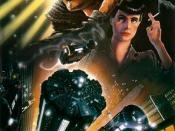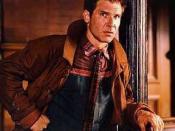The cinematic construction of Blade Runner: The Director's Cut helps to enhance the audience's understanding of what it means to be human. The author, Ridley Scott, has created one of the most thought provoking science fiction films since 2001: A Space Odyssey. Based on Philip K Dick's novella, Do Androids Dream of Electric Sheep?, the film presents a world that is both similar and disturbingly different to the audience. Blade Runner has been influential in the development of science fiction films that deals with high-tech apocalyptic futures. Scott wants the audience to understand the nature of being human, the threat of environmental degradation, the nature of social stratification, the triumph of morality, illusion and reality and the notion of paranoia. The opening credits and crawl of information as well as his use of film noir, motifs, imagery and technical devices has strengthened the audience's understanding of the main ideas of the film.
The opening sequence of Blade Runner: The Director's Cut evokes feelings of darkness, bleakness and foreboding. The most powerful and suggesting feature that evokes such feelings is the music played during the opening prologue. The music, composed by Vangelis, is both futuristic and haunting. The music also gives the audience a feeling of hopelessness and despair. The opening crawl of information also gives credibility to the film making it more like a documentary than a fantasy. The relatively slow pace of the information emphasizes its importance. The opening of Blade Runner prepares the audience for they are about to see and hear.
Scott's use of "film noir" subtlety enhances the audience's understanding of Blade Runner: The Director's Cut. The term refers to a film set in a gloomy urban environment. It has been characterised in classics, such as Casablanca, by night scenes, darkened rooms, alleys,


